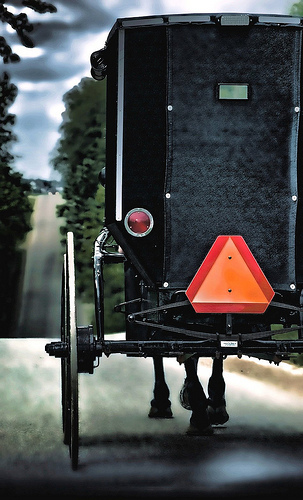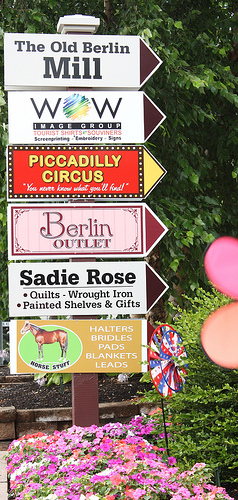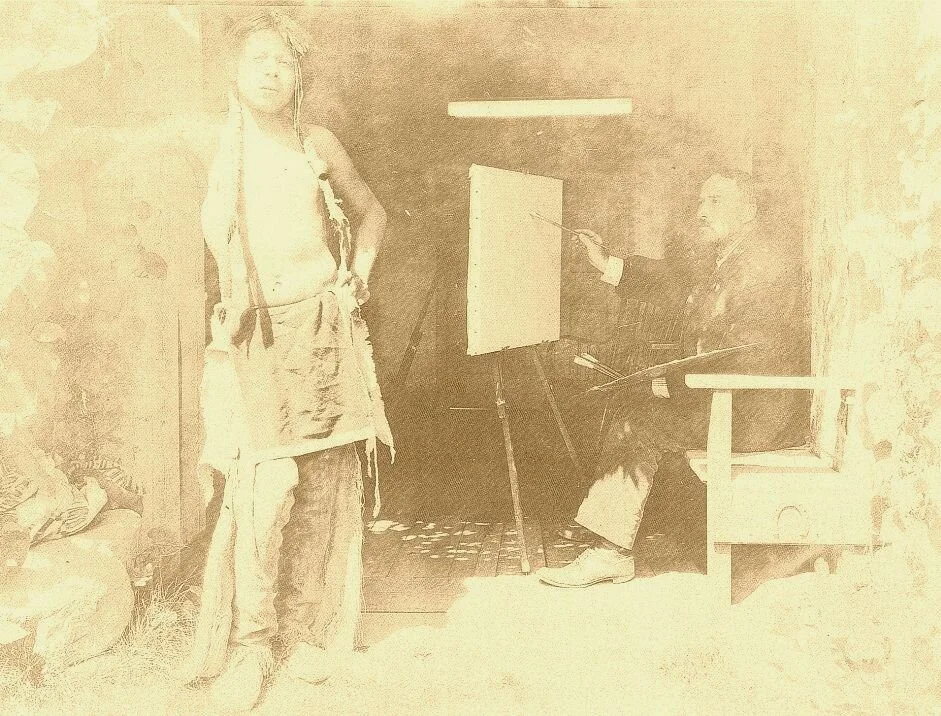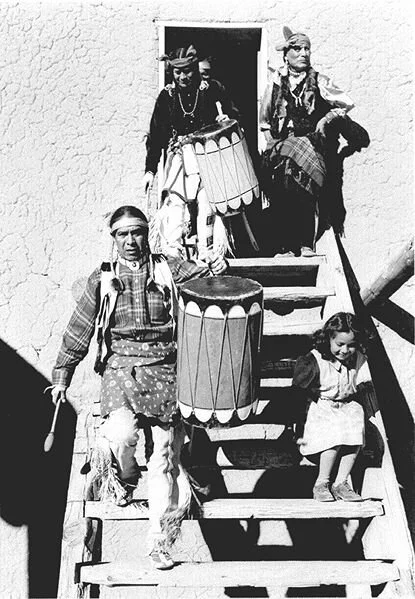What are all these tourists doing tramping around in these small towns, smashing what is left of rural life? That was my uncharitable thought when I returned to Ohio for a class reunion and drove up to Berlin (pronounced BER-lin ever since World War II) and Walnut Creek, and Charm. These little towns stand in the heart of Ohio's “Switzerland” – Amish country--and I was on my way to buy some locally made Swiss cheese. I came away with Swiss cheese and culture shock.
 by leezie5 via flickr.comI grew up in Holmes County, Ohio. While not as well known as Lancaster Pennsylvania, Holmes County and neighboring counties are the homeland of the Plain People--the Amish and their slightly more permissive cousins, the Mennonites. Back when I was a child, we knew several things about the Amish. They wore mostly black. They managed excellent farms and if we wanted a cabinet built, we would look for an Amish carpenter. But mostly, our interaction with them was on the road. Because they do not drive anything mechanized, their horse-drawn buggies were a road hazard to our '57 Che vies and '60 Pontiac, frequently causing lines of traffic to crawl along narrow county roads.
by leezie5 via flickr.comI grew up in Holmes County, Ohio. While not as well known as Lancaster Pennsylvania, Holmes County and neighboring counties are the homeland of the Plain People--the Amish and their slightly more permissive cousins, the Mennonites. Back when I was a child, we knew several things about the Amish. They wore mostly black. They managed excellent farms and if we wanted a cabinet built, we would look for an Amish carpenter. But mostly, our interaction with them was on the road. Because they do not drive anything mechanized, their horse-drawn buggies were a road hazard to our '57 Che vies and '60 Pontiac, frequently causing lines of traffic to crawl along narrow county roads.
On my drive in search of cheese, I enjoyed the gentle hills glowing soft green in the humid air. The Amish farms stand out with their sprawling white houses extended by additions piled on like a collapsed stack of children's blocks. Depending on the season, you may see a horse-drawn plow in the field, or geometric patterns of domed haystacks stretching across the fields. The countryside has a Grandmother-Moses-was-here look about it.
I chuckled as traffic slowed to a crawl and I stretched my neck expecting to see the familiar buggy that was blocking traffic. Except it was not a buggy. It was a tour bus. That is when culture shock set it.
Berlin was a tourist destination? BERlin? One of those small towns that we who grew up there could not wait to get out of, was now a magnet for day trippers from Cleveland and Columbus and Chicago? From my youth, I identified Berlin as a hopeless backwater, only important as a prime basketball rival. Among us girls it was famous as the home of a family of five boys--all tall, dark and incredibly handsome. I doubted that the tour buses were on their way to a county basketball tournament.
Then I saw the signs along the road. “Tour a Real Amish Farm” and “Home-cooked food, Amish Style”, and “Homemade Pies”, and “Amish Quilts”. And it sunk in. The Amish had become trendy. Holmes County, instead of being a place where the only people who stayed were those who couldn't get away, or those whose religion mandated they stay put, was now a magnet to the over privileged.
All those tour bus loads of people came yearning to glimpse some sort of Brigadoon experience--the rural life they imagined to be so superior to their busy, cushy city life. And they were willing to spend money to try it out for a day or two. And they would spend more money to take home souvenirs. The once utilitarian grocery store, filling station and coffee shop have been crowded out by brightly painted faux-country facades of stores selling candles, pottery, and sweatshirts made in China.
 by billrock54 via flickr.comLater I learned that nine out of ten of the establishments in the tourist areas with names like Olde Country Shoppe and Kountry Krafts are not owned by Amish, or even Ohioans, but by people from alien lands like New Jersey. Which may account for the bizarre spelling, who knows?
by billrock54 via flickr.comLater I learned that nine out of ten of the establishments in the tourist areas with names like Olde Country Shoppe and Kountry Krafts are not owned by Amish, or even Ohioans, but by people from alien lands like New Jersey. Which may account for the bizarre spelling, who knows?
Aside from regretting the lack of reality prevalent in this recreated vision of rural Ohio, I could understand people enjoying the lovely landscape--patches of dense woods alternating with plush farmland. But what struck me was that these tourists thought they were experiencing something authentic, and by their very presence they had destroyed the real small towns and substituted a Disneyfied version of rural Americana
Just when I thought I had begun to understand this new definition of tourist attraction, I learned that a scenic byway focuses on the small town I came from. The attraction? Swampland. That would be the swamp that swallowed up my great-grandfather's rich bottomland farm. The once-picturesque creek that attracted Eastern settlers in the 18th century and American Indian tribes long before that, began to age and spread flabbily across the valley. My great-grandfather, the town doctor, fought valiantly to have the government clean up the creek to prevent the destruction of such rich farmland. Had he been successful, there would not be a scenic byway, horseback, hiking, biking and canoe trails to attract tourists today.
For the townspeople, the swamp not only means loss of farmland and income, it also breeds mosquitoes, drove away the once plentiful deer, regularly floods the town, and has destroyed roads to nearby homes. But for the tourists, it is a wonder of nature that for all they know has always been there. (And isn't it quaint, they must be thinking, that these people built a town in a swamp?)
Is this me, I worry? Am I enjoying my travel experiences so much that I forget to notice what is authentic and what is created just for my enjoyment? Am I ignorant of the effect of changes on the people who have lived in a place for generations?
Am I this foolish when I go to a Greek island in search of genuine Greek village life or cheer when modern life is disrupted in order to uncover Etruscan ruins in Italy? Do I want people to live a quaint life for my viewing pleasure? Am I just a little sad when an electric cable is strung into the jungles in South American and yet another “uncivilized tribe” sees light?
For instance, I am about to visit a prison, infamous in the 19th century and early 20th century for cruel treatment of prisoners and unsanitary and unsafe conditions. Fortunately for the internees, the prison was finally closed in the 1970's and the prisoners moved to more humane conditions. But how unfortunate for me, the tourist. How much more exciting it would be if there were real people inhabiting those hundreds of cells. How much more exciting to peer into the life of someone in solitary confinement. Of course, I don't want to actually LIVE in one of those cells. Maybe I could just visit for a few hours and call it an authentic experience? Then I could retire to the themed bed and breakfast next door and the gift shop that sells striped t-shirts and make-believe shivs for a little shopping.
Vera Marie Badertscher is a travel writer who reads when she is not traveling. She publishes the blog A Traveler's Library (http://atravelerslibrary.com) where she and several co-conspirators discusses books and movies and other inspirations for travel.


